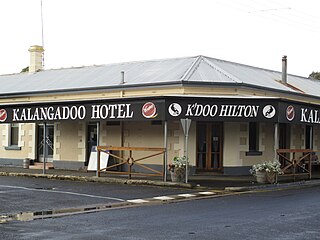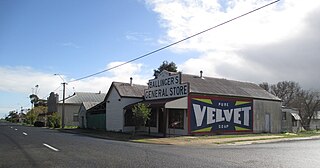
Naracoorte is a town in the Limestone Coast region of South Australia, approximately 336 kilometres south-east of Adelaide and 100 kilometres north of Mount Gambier on the Riddoch Highway (A66).

Rail transport in the Australian state of South Australia is provided by a number of railway operators who operate over the government-owned railway lines. The network consists of 1435 mm standard gauge links to other states, the 1600 mm broad gauge suburban railways in Adelaide, a freight-only branch from Dry Creek to Port Adelaide and Pelican Point, a narrow-gauge gypsum haulage line on the Eyre Peninsula, and both copper–gold concentrate and coal on the standard-gauge line in the Adelaide–Darwin rail corridor north of Tarcoola.

Kalangadoo, formerly Kalangadoo East, is a locality in the Australian state of South Australia located about 348 kilometres (216 mi) south-east of the state capital of Adelaide and about 31 kilometres (19 mi) north of the regional centre of Mount Gambier.

Wolseley is a small South Australian town near the Victorian border. It is five kilometres south of the Dukes Highway and 13 kilometres east of Bordertown. It was first proclaimed a town in 1884.

Nairne railway station, now closed, is on the Adelaide–Melbourne railway line, which passes through the Adelaide Hills town of Nairne. It is 56.1 km (34.9 mi) by rail from Adelaide station or 30.3 kilometres in a direct line south-east from the centre of Adelaide.
The Adelaide–Wolseley railway line is a 313 kilometre line running from Adelaide to Wolseley on the Australian Rail Track Corporation network. It is the South Australian section of the Melbourne–Adelaide railway.
Glencoe is a town in South Australia, Australia, located 27 kilometres (17 mi) north-west of Mount Gambier.
Wandilo is a north-western suburb of Mount Gambier in the Australian state of South Australia. It was named after the railway station on the Mount Gambier railway line, and is recorded to mean "a swamp where native companions resort".

Mount Gambier railway station was the terminus of the Mount Gambier railway line and the junction for the Beachport and Mount Gambier-Heywood railway lines in the South Australian city of Mount Gambier. It was last used in 2006, and has since been transformed into a public community space.

The District Council of Wirrega was a short-lived local government area in South Australia in existence from 1884 to 1888.
Wolseley railway station was located at the junction of the Adelaide-Wolseley railway line and the Mount Gambier railway line. It served the town of Wolseley, South Australia.
Custon is a locality in the Australian state of South Australia located in the state's south-east within the Limestone Coast region about 267 kilometres south east of the state capital of Adelaide, about 19.5 kilometres south-east of the municipal seat of Bordertown and adjoining the border with the State of Victoria.
Dismal Swamp is a locality in the Australian state of South Australia located about 361 kilometres (224 mi) south-east of the state capital of Adelaide and about 19 kilometres (12 mi) north-west of the municipal seat of Mount Gambier.
Naracoorte railway station was located on the junction of the Mount Gambier railway line and the Kingston SE railway line. It served the town of Naracoorte.
Penola railway station was located on the Mount Gambier railway line in the South Australian town of Penola.

Coonawarra railway station was located on the Mount Gambier railway line. It served the town of Coonawarra.

Keith railway station was located on the Adelaide-Wolseley line in Keith, South Australia.

Kalangadoo railway station was located on the Mount Gambier railway line. It served the town of Kalangadoo, South Australia.
Glenroy railway station was located on the Mount Gambier railway line. It served the locality of Glenroy, South Australia.












